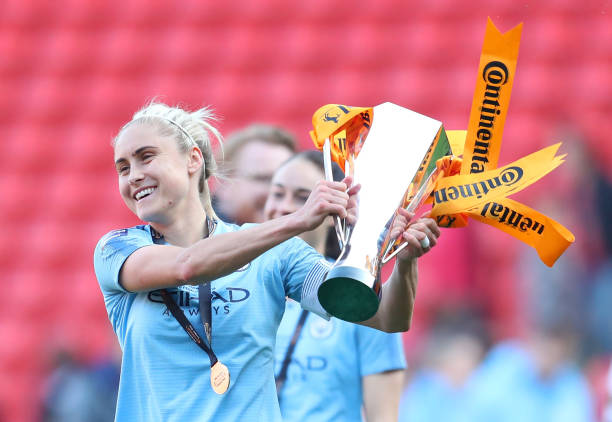What comes first, the interest or the coverage?
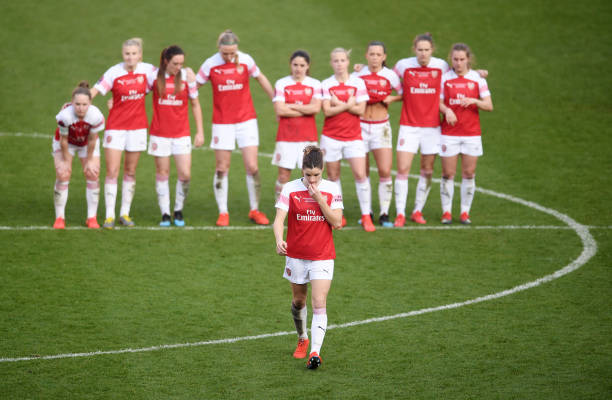
On Saturday afternoon, Arsenal faced Manchester City in the Conti Cup final, not that you’d know it from the coverage in Sunday’s papers.
I can hear some of you already and it’s a tiresome argument. There is little coverage of women’s football, ‘you’ say, because there is little interest.
That’s simply not true.
And it’s as stupid as saying there was no interest in English football before the arrival of the Premier League. There was less, but once it was marketed properly, it became the leading league on the planet.
Two of the biggest Sunday papers in the country dedicated less than a third of a page to coverage of the Saturday’s final BETWEEN THEM.
The Sunday Telegraph at least gave us a match report, all be it one that took up significantly less space than most other stories this weekend.
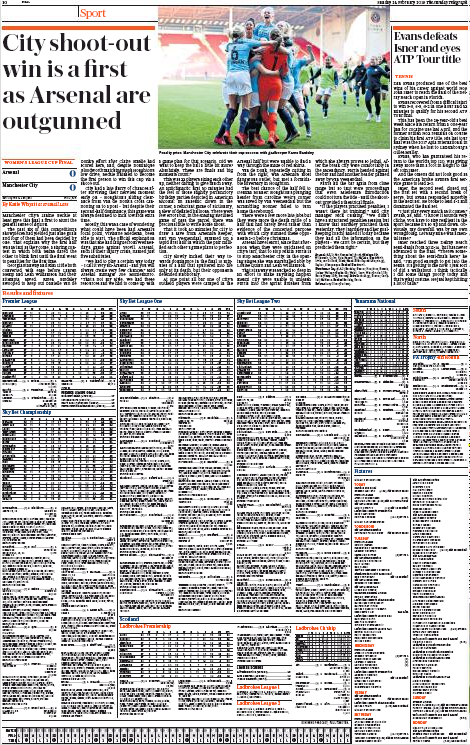
The Mail on Sunday? They provided a teeny tiny box of coverage totalling 89 words, including the headline.
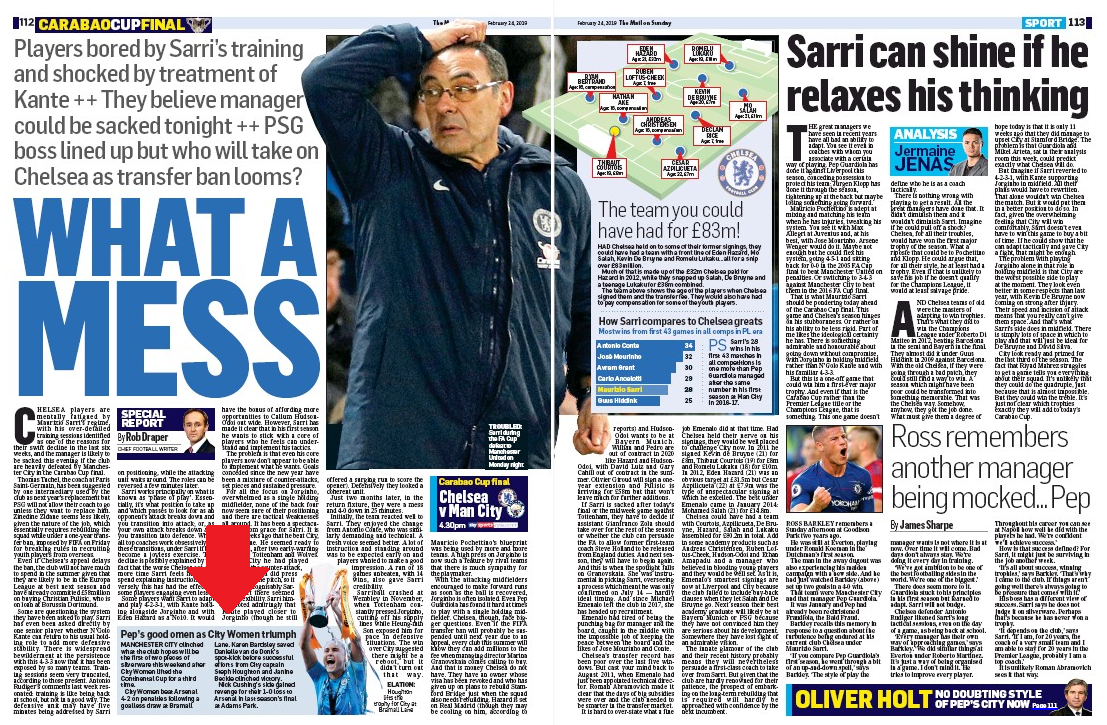
When you raise this issue on social media, it doesn’t take long for some bloke who has never thought about the matter to inform you the reason there is so little coverage is because there is no interest, that women’s football is no good compared to men’s, and if there was demand for more coverage, we would get more coverage.
Let me tell you a little story about why that bloke is wrong…
Malcolm Gladwell explained in Outliers why talent is not what takes a person to the top. He shows that where you come from and when you’re born is just as important, but his theory also translates across gender lines and helps explain why women’s football still struggles.
![Arsenal v Manchester City: 2 UK papers disgrace themselves with Conti Cup final coverage 5 During WW1 female matches raised money for charities [image via Patrick Brennan]](https://dailycannon.com/static/uploads/1/2019/02/79634469_1921_llanelli_women.jpg%22)
Let me explain…
From she could walk she was trying to kick a football. As she grew independent enough to be allowed outside with her peers, she was on the streets playing football until her mum would shout that it was time to come in for dinner. Then followed a competition to stuff the food into her face as quickly as possible to get back out on to the streets to play football again. It didn’t matter if 20 boys were playing or just one, all she wanted to do was play.
At primary school, Sarah wasn’t allowed to play in actual games so amused herself playing during break and lunch. Her friend, David, wasn’t anything special with the ball at his feet, but because he was male, he was afforded the chance to play in a team and learn about the game at a slightly deeper level. He got to play more and when he talked about football adults engaged with him. Some encouraged and challenged him, others praised his ability. When Sarah spoke about football, most adults humoured her or thought it ‘cute’ that she was trying to talk about what was clearly a ‘man’s game’.
When it was time to go to secondary school, Sarah was sent off to an all-girls’ school. Although it was academically superior to the school David joined and had a healthy and extensive sports programme, football was not on offer. This was 1986. Girls didn’t play football then.
David, however, went to a school that had a decent football team and he was quickly on the fringes of it. Although still not anything spectacular, he was willing to work hard and coaches started to offer him places in sessions after school. He started to develop the technical side of his game and, by the end of the first year, after he had extra coaching while Sarah hasn’t even kicked a ball, a cavern emerges between the perceived footballing ability of the pair who were identical just 12 months earlier.
These two people don’t actually exist. They are a composite of people and situations I knew growing up but the story is a clear example of how some men go on to be superior when it comes to playing football and why, as a result, we continue to feed the circle that keeps this inequality in play.
We can point to puberty and the release of hormones as one reason many people think men are better at football than women (and I realise that’s a massive generalisation, most men won’t be anywhere near as good as women who play the sport professionally) but that would merely explain why men are stronger than women. The ability to control a football and make it move where you want it to in a way that you determine is a learned skill. It doesn’t depend on what hormone is in your system or what genitals rest between your legs.
The simple reason the women’s game has not reached the same level as the men’s is because it is not taken seriously enough and the media claim there isn’t any interest. Boys are regularly offered opportunities denied to girls, they are encouraged to play football when girls are discouraged. These things matter, small as they are.
When they combine, they result in a massive distortion.
But it wasn’t always like this…
Not an even playing field
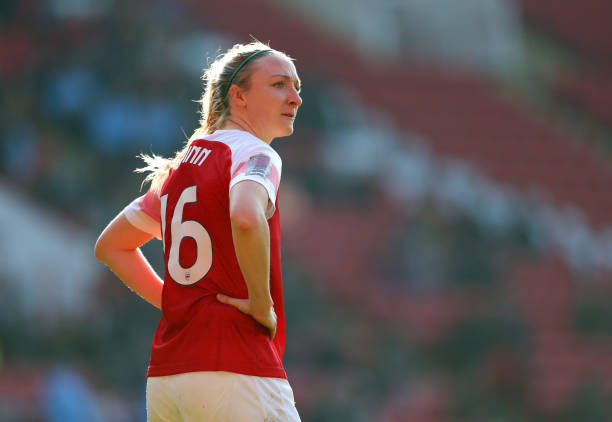
Football hasn’t always been with us, although it often feels like that. It’s a game that nobody – male, female or non-binary – knew how to play before 1863. By 1920, some women’s games were attracting over 50,000 supporters and some grounds were too small to cope with the demand to watch them play.
Contrast that with today where one of the stated aims of the rejigged Women’s Super League is to increase regular gates to 2,000.
So how did that happen? How did a sport, that was once engaging enough to generate demand that could not be met fall so low it struggles to get any broadcast coverage and often sees just a few hundred turn up to games?
Lily Parr was a player who had a shot so fierce she once broke the arm of a male goalkeeper. The first female player to be sent off for fighting, she stood over 6ft tall and scored more than 1,000 goals in a career that spanned 31-years. She debuted at 14 and scored 34 goals in her first season.
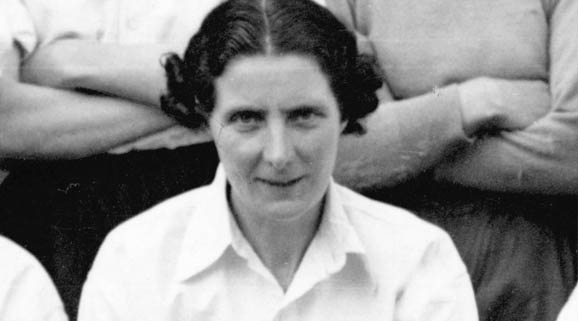
Along with some other factory workers from Preston, she formed part of the Dick Kerr Ladies, the biggest draw in world football but they started at a time when many men who would have been playing were off fighting in World War I. Although women’s football had been in place prior to the breakout of war, like with so many other industries, it was only when the country was desperate did they allow women to fulfill roles traditional serviced by men. Those women then, of course, surprised many by being more than capable of doing whatever that was asked of them.
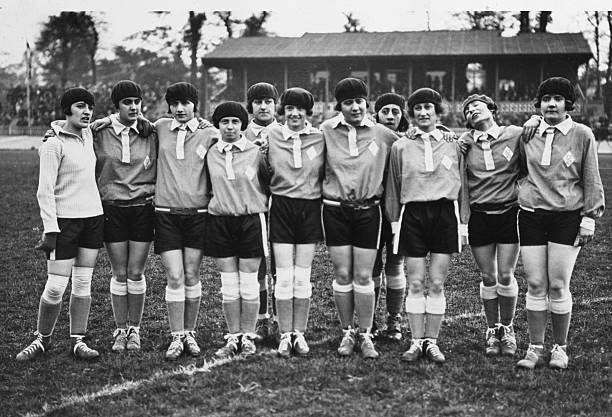
Informal kickabouts started at factories but as the war wore on, the game became more formalised, and games, that started as a novelty, soon became established as people willingly turned up to watch because of the skill of the players.
When the war came to an end people continued to turn up to watch women’s football in their tens of thousands. But the establishment wanted women back in the kitchen, where they belonged. If you’re female and involved in football today, chances are you already know that’s where you’re supposed to be.
None too pleased at this new-found freedom women had been handed, the FA declared football unsuitable for females in 1921 and called on clubs belonging to the associations “to refuse the use of their grounds for such matches.” It didn’t matter that their war effort had been every bit as integral as the men fighting on the front, women would not be allowed to continue in this manner.
Today, almost 100 years later, the women’s game is still fighting to recover.
Those years show us clearly there is an appetite to watch women’s football from the general public and that women, as we see clearly today if we pay enough attention, are more than capable of producing football that entertains the masses.
But if you stopped a random sample of men on the street and asked them about women’s football, they would be clueless. Women just aren’t as good as men and that’s all there is to it.
It is, after all, a ‘man’s’ game.
It’s not and never has been but to break the cycle we find ourselves in, something is going to have to give. Either the media need to start giving women’s football significantly more coverage to show the public that this is something they should care about, or the public needs to change its mind all by itself. That hardly seems likely.
The FA didn’t lift the ban on women’s football for 50 years.
TV wasn’t invented until six years after women’s football was banned. The BBC only introduced colour television four years before it was restored. It’s no wonder the public have ‘no interest’.
By the time women were allowed to kick a ball again the men’s game had seen untold investment and exposure.
I wonder if anyone back then said, ‘it’s probably not worth it?’
In November, Martin Samuel the Daily Mail’s Gammon-in-chief, explained it very clearly why there is so little coverage of the women’s game – it’s because the men in charge, like him, think it’s not ‘super’ enough.
Read about that next…
As I made my way through the papers on a cold November morning, I couldn’t help but notice a distinct lack of coverage regarding Jordan Nobbs’ ACL injury, but I did notice Martin Samuel in the Daily Mail complaining that the Women’s Super League just isn’t super enough to warrant coverage in a national newspaper.
His piece, which is small yet all over the place, started as a bit of a gripe about referee David McNamara’s three-week suspension for using rock, paper, scissors to determine who should kick off after he forgot his coin for the toss. Mostly, though, it seems he just wanted to point out that he thinks he was right about something – “What this column highlighted,” he writes, “was the gulf between what is termed a ‘super’ league and its reality: officials and infrastructure that are not up to the job and, in particular, attendances that do not support some hefty claims.” He doesn’t clarify what these claims are.

Samuel’s first two points, that officials and infrastructure are not up to the job are on the money, but his gripe about attendances is flippant yet clearly where his main problem lies.
His misogyny, however, comes to the fore in his next sentence. “The women’s league is pushed, projected and shoved into the limelight yet in many aspects is running before it can walk,” Samuel complains, as if showing the league leaders live via the BBC red button is somehow akin to beaming it straight into everyone’s brains. “The extra attention devoted to the women’s league is not being reflected in attendances and financial strength.”
Extra attention!
One of the best midfielders in the women’s game, a player who has been scoring and assisting for fun this season, ruptured her ACL at the weekend putting her World Cup participation for England in doubt. The news, confirmed by Arsenal on Monday afternoon, received no mention in Tuesday’s Daily Mail, Daily Telegraph, or Daily Express, with just a quarter of a column in the Guardian (96 words including the headline), and 18 words in the Daily Star.
An argument could be made that the reason women’s football still struggles these days is precisely because it HASN’T been shoved into the limelight in the ways Samuel suggests, at least not effectively. If you want to know what a successful marketing campaign can do for a sport, just look at how the Premier League was rebranded as the very start of football itself and compare the money in the game now to pre-Sky Sports days.
In his piece, Samuel also counted the number of words in an article – in a national newspaper no less – about Arsenal’s recent 4-0 win over Everton on a weekend with no Premier League football (734 words) and notes how this was exactly double the attendance at the match.
Imagine that, one whole article about one of the leading teams in the country. Saturation point must surely be just around the corner. Plus, we should all be suspicious of math that tidy.
While at the end of his piece he seemed to call for the authorities in the game to get their act together, it was hard to read his column and not see it as a snide attack on the women’s game.
Herein lies one of the biggest perceived chicken-and-egg problems with women’s football.
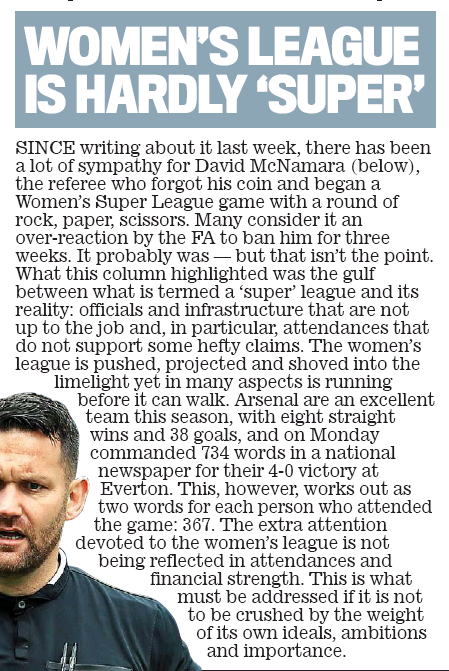
Some say there is little coverage of the game because there is little interest while others point to the fact that you need to generate interest to produce it. But the interest in women’s football is absolutely there and always has been, even if the FA did their best to crush it when they banned women’s football for 50 years because it was too popular. It’s just ignored or, at best, not taken seriously.
Football hasn’t always been with us, although it often feels like that. It’s a game that nobody – male, female or non-binary – knew how to play before 1863. By 1920, some women’s games were attracting over 50,000 supporters and some grounds were too small to cope with the demand to watch them play. Tell me again how it is ‘obviously a man’s game’?
It’s not and never has been but to break the cycle we find ourselves in, something is going to have to give. Either the media need to start giving women’s football significantly more coverage to show the public that this is something they can openly care about, or the wider public needs to change its attitude all by itself.
TV wasn’t invented until six years after women’s football was first banned. The BBC only introduced colour television four years before it was restored. By the time women were allowed to kick a ball again the men’s game had seen untold investment and exposure.
I wonder if anyone back then said, ‘it’s not super enough and probably not worth it?’
